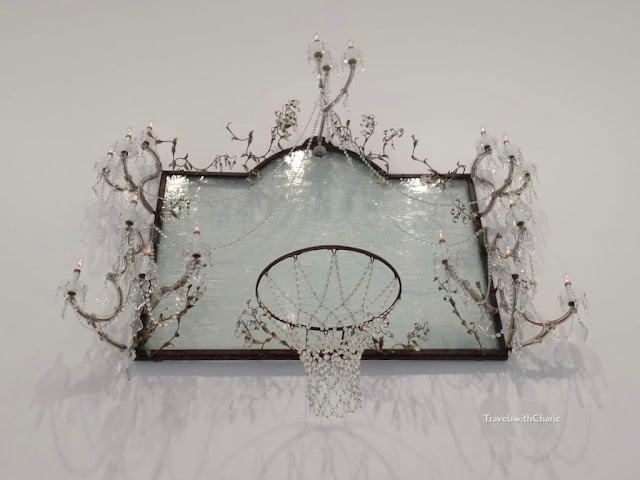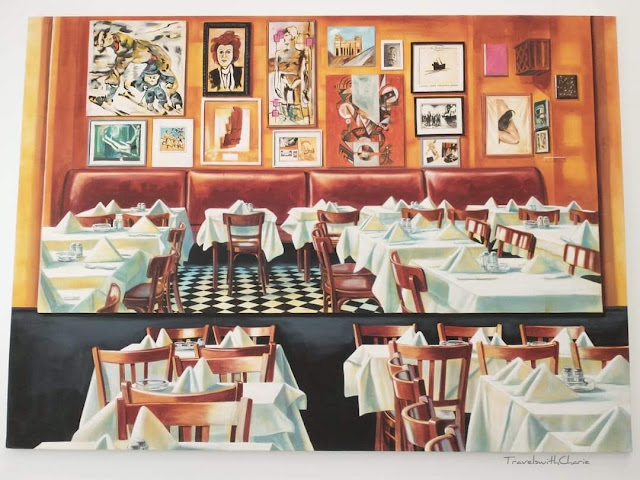Untitled, Urs Fischer, 2011
The first thing that struck me about the Bourse Museum is the neo classical aesthetic of both its façade and Rotunda. The vast light-filled Rotunda draws the eyes to the metal and glass dome above and the panoramic fresco, Triumphal France, that surrounds the cupola. Without taking away the architectural integrity of a historical landmark, Tadao Ando restored and renovated the former stock exchange building into a museum for contemporary art for the collection of François Pinault, a French art collector.
“The spatial layout of the Bourse de Commerce is designed to create an intense and more subtle dialogue between new and old.” Tadao Ando
The wax sculpture by Urs Fischer, a Swiss artist, claims the central position in the Rotunda. It is a replica of The Abduction of Sabine Women by Giambologna. Fischer’s other works surround this sculpture.
Even the birds love this museum. Wait a minute, are they for real?Others by Maurizio Cattelan, 2011. (Pigeons)
This is my favorite painting in the entire collection. I feel like I’m there at the Paris Bar waiting to be ushered to my table, hoping I will be sitting with a view of the paintings on the wall.
Untitled, Urs Fischer, 2011-2020 (figure of Rudolph Stingel)
The impermanence of things.Untitled, Urs Fischer
2020 travel plans.
Hoop dreams?
David Hammons is an African American artist whose works include assemblages, recycled objects picked up from his wanderings, sculptures, paintings, works on paper. Pinault started collecting Hammons’ works over twenty years ago and they are together in one space for the first time at the Bourse Museum. It is a rare occasion when Hammons’ oeuvres are exhibited in a cultural institution.
“I am an artist, but I am not on the side of the art world. I decided a long time ago that the less I did, the more I would be an artist.” David Hammons
Hammons’ artistic works are an exploration into Black identity in the United States.
David Hammons
Gives new meaning to the words, trash bag.
Untitled, Kerry James Marshall
“If you look at the historical narrative of art, we do have to contend with this idea of “old masters”. And that I have to recognize that in that pantheon of old masters, there are no black old masters.” Kerry James Marshall, Interview with Museum of Contemporary Art Chicago
Christos, Bertrand Lavier
Blue, Bertrand Lavier
They always want us to believe otherwise.The Pinault Collection website describes Lavier’s works as “irreverent and literate body of work, iconoclastic as much as iconophile, are called construction sites”.
One of these vases is fake, Bertrand Lavier
How important is it to know?
It’s a Party Angry, Florian Krewer
Contemporary triptych.
Not quite as clear, Florian Krewer, 2019
Notice the heads on the wall below the upper windows. These are by Thomas Schütte.
Ici Plage, comme ici bas, Martial Raysse, 2012
The more, the merrier? Not quite.We sure do!
Paris Bar, Martin Kippenberger, 1993
Art imitates life imitating art.
Marlene Dumas excels in capturing the human condition from images gathered and brought to life as she has done in Angels in Uniform. The children here are from an orphanage in Milan.
“Painting is about the trace of the human touch. It is about the skin of a surface.”
Marlene Dumas
Sesta, Antonio Obá, 2019
Brazilian artist Antonio Obá comes from a background with rich cultural and religious influences that are often the central theme of his artworks. In Sesta, the young boy awakes in a wheat field. He’s holding a pair of scissors. Did he hear the black cat coming? Reflections about contemporary art:
Frankly, it’s often difficult to understand or appreciate contemporary art. Who makes the call that a piece of work is art - the art collector with the money to buy the works presented to him by an art dealer, the art historian, the art connoisseur, or the viewer who is confused by what he/she sees and is told that what he sees is art?
This is a quote from François Pinault who owns these artworks we see here:
“Art from the past is interesting, but we must also pay attention to what is happening in the world today and also to the future.”
How to get there:
2 rue de Viarmes/15 Rue du Louvre
Metro Châtelet-Let Halles/Louvre-Rivoli
Entrance fee. Purchase tickets in separate building in front of the museum where you can book the time of entry. This can also be done online. Free entrance first Saturday of the month from 5 pm to 9 pm. Please read carefully the health measures required to enter the museum at this time due to covid-19.
*****
Images by TravelswithCharie


















